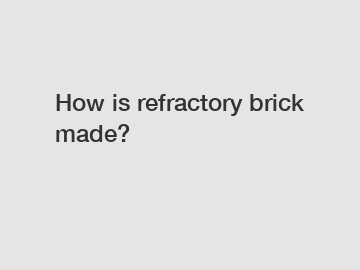How is refractory brick made?
How is Refractory Brick Made?
Refractory brick is a vital material used in industries that require high temperature resistant structures such as furnaces, kilns, and incinerators. These bricks have exceptional thermal and chemical properties that allow them to withstand intense heat and harsh conditions. To better understand the manufacturing process of refractory bricks, let's delve into the details.
Raw Materials:

The production of refractory bricks begins with carefully selected raw materials. The main constituents are fire clay, silica, alumina, and other refractory compounds. Fire clay forms the base material due to its ability to withstand high temperatures and maintain structural integrity. Silica and alumina are mixed in specific proportions to impart desired properties such as high heat resistance and low thermal conductivity.
Mixing and Shaping:
Once the raw materials are obtained, they are mixed according to predetermined proportions. The mixture is made homogeneous using wet or dry blending techniques. Water is added as a binding agent to enable the formation of a plastic mass that can be shaped easily. The plastic mass is then compressed and shaped into bricks using a mold or extrusion process. The shaping method depends on the type and size of brick desired.
Drying:
After shaping, the damp refractory bricks are subjected to a drying process. This step is crucial to remove any excess moisture and improve the bricks' strength and density. Drying can be natural or artificial, with the latter being more commonly used in modern refractory brick manufacturing. The bricks are typically dried in specialized chambers or kilns at controlled temperatures to prevent cracking or deformation.
Firing:
The dried bricks are then fired at high temperatures, known as firing or sintering. Firing is a critical step as it creates strong chemical bonds between the refractory compounds, resulting in enhanced strength and durability. During firing, the refractory bricks are exposed to temperatures ranging from 1300 to 1800 degrees Celsius, depending on the specific requirements of the end application. This process transforms the raw materials into a solid, dense and heat-resistant brick.
Quality Control:
To ensure the production of high-quality refractory bricks, rigorous quality control measures are implemented. The bricks undergo various tests such as thermal conductivity, compressive strength, shrinkage, porosity, and chemical resistance. These tests help determine the suitability of bricks for specific industrial requirements. Any bricks that fail to meet the defined standards are rejected and recycled into the manufacturing process again, maintaining high product consistency.
Closing Paragraph:
In conclusion, refractory bricks are manufactured using a well-defined process to ensure optimal heat resistance and durability. From the selection of raw materials to the final quality control, each stage is crucial in producing bricks that can withstand extreme conditions. These bricks play a vital role in industries that operate at high temperatures, such as metal and glass manufacturing, cement production, and power plants. If you require refractory bricks or further information, please feel free to contact us.
Contact Us:
For more information or to inquire about our refractory brick products, please contact us at [insert contact details here]. We are dedicated to providing high-quality refractory solutions tailored to your specific needs.
If you want to learn more, please visit our website industrial furnaces refractory bricks, ceramic fibre blanket dealer, castable refractory cement.

Comments
0